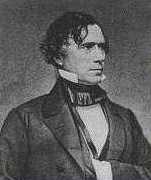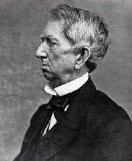At the beginning of the Civil War wild rumors were sweeping through the northern states about plots to overthrow the government. These plots were supposedly organized by various secret societies of Southern sympathizers. One group in particular, known as the Knights of the Golden Circle, was especially feared. This secret society really did exist, and many northerners feared that its members were organizing in the midwest to lead a pro-Southern insurrection.
Republicans (the party of Abraham Lincoln) played on these popular fears to their advantage by claiming that their Democratic opponents were in league with these secret societies and were intending to bring down the government.

President Franklin Pierce
Into this atmosphere of paranoia a letter appeared in March of 1862 published by two Republican papers that implicated ex-President Franklin Pierce, a democrat, in one of these feared treasonous plots. The letter appeared to be from a member of the Knights of the Golden Circle and described how "Presdt. P__" (easily recognizable to contemporary readers as an abbreviation for President Pierce) had secretly met with members of the Knights of the Golden Circle during a trip through Michigan, and was in league with them to overthrow the government.
The letter, which was three pages long, included these passages:
"I have it from the best authority that the League is doing noble work in M__a, even among the F__S.__ at Ft.___. If God continues to prosper our efforts, the hour of a Union between N.& S. is not far distant. Prepared and united, our force will prove irresistable [sic] and the accursed Aj ___ G.__ will be swept into the Atlantic.
Presdt. P_____ in his passage has drawn many brave and influential men to the League."
The letter was signed in code and dated October 5, 1861.
If the letter was real it would obviously have been serious evidence of treason. However, the letter was not real at all. It was, instead, part of a rather hare-brained hoax hatched by a man named Dr. Guy S. Hopkins.
The genesis of the letter was this: Ex-President Pierce had briefly visited Michigan in September, 1861. He had met with a few friends and reportedly expressed to them his opinion that he didn't like Lincoln and would much prefer to see Joseph Holt as president.
News of these comments leaked out to the editors of a local republican newspaper, and they reported Pierce's words as evidence of his participation in a treasonous plot, proclaiming, "While in this city, he [Pierce] was closeted with a select circle who are known to be doubtful in their loyalty... Our opinion is Franklin Pierce is a prowling traitor spy."
Dr. Guy S. Hopkins, a staunch democrat, decided to retaliate in defense of Pierce, though he chose a fairly complicated and unlikely means to do so. He penned a false letter, apparently from a member of the Knights of the Golden Circle, detailing various treasonous activities undertaken by "Presdt. P" on a trip through the midwest. His plan was that the letter would be leaked to the Republican press, who would believe it to be true and publish it. Hopkins would then reveal that he had, in fact, written the letter himself, thus revealing the Republicans to be gullible fools.
As Hopkins himself said: "it would be sent to one of the treason-shrieking presses and when exploded would produce much 'fun'."

Secretary of State William Seward
The letter was duly leaked to two Republican papers, the
Detroit Advertiser and the
Detroit Tribune, but instead of publishing it they forwarded it to a federal marshal, who then forwarded it to Secretary of State William Seward.
Seward believed the letter to be real and immediately ordered the arrest of possible traitors in Michigan, one of whom happened to be Dr. Hopkins. He also wrote to Pierce and informed him of the charges made against him. Pierce angrily responded, denying all charges of treason.
Meanwhile, Hopkins, in jail, quickly confessed to what he had done, but Seward, learning the truth, decided to suppress the fact that he had been taken in by a hoax. Therefore, he wrote a conciliatory letter back to Pierce saying that the previous letter had been a misunderstanding, but he did not reveal that Hopkins had confessed nor that he knew the charges against the ex-President to be completely false.
This might have been the end of the matter, but then in March 1862, the Republican papers decided to publish Hopkins's letter after all, and other papers throughout the nation quickly reprinted it. This meant that the false charges made against Pierce became highly public, and Pierce felt that he had to officially clear his name.
Pierce's friends in the Senate passed a resolution calling upon Seward to make public the correspondence between him and Pierce, and so clear Pierce's name. However, Seward continued to try to suppress the fact that he had been taken in by Hopkins's phony letter. Therefore, Pierce's friends managed to clandestinely gain the incriminating letters from Seward's files and read them out loud before the senate, thus revealing Seward's attempted cover-up.
Seward was publicly embarrassed, and Pierce was vindicated. However, the experience left a bitter taste in Pierce's mouth, and he became a vocal critic of the Lincoln administration for the remainder of the Civil War.
Links and References
- Klement, Frank L. "Franklin Pierce And The Treason Charges Of 1861-1862". Historian 1961 23(4): 436-448.
- Klement, Frank L. "The Hopkins Hoax And Golden Circle Rumors In Michigan: 1861-1862". Michigan History 1963 47(1): 1-14.



Comments